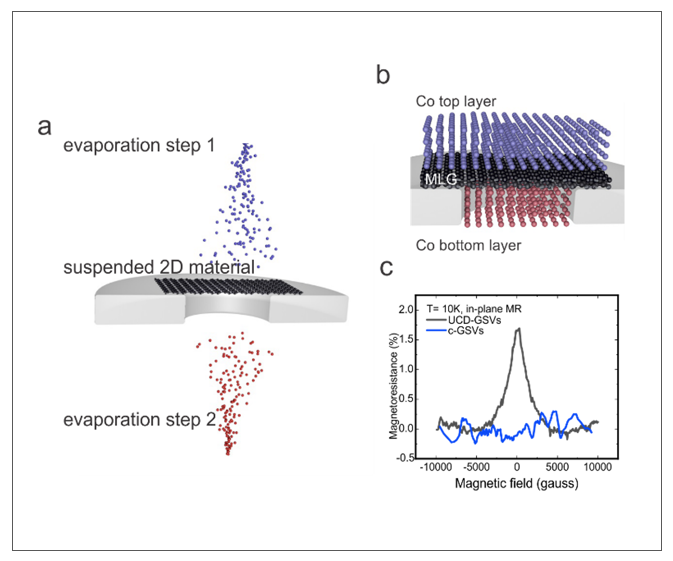磁性金屬與二維材料介面之直接觀測
Direct probes at the interface between magnetic metals and two-dimensional materials
計畫主持人:臺大-物理系 謝馬利歐、中研院-原分所 江正天
自旋電子學是一項利用電子自旋與磁矩來創新電子設備的技術,它被期待能夠提升電子元件的性能、效率以及可擴展性。自旋閥是自旋電子學的基礎元件,其結構包含兩側的鐵磁層以及中間有一非磁性間隔層,透過外部磁場調整鐵磁層的自旋方向可以造成磁阻改變,越高的磁阻變化率可以提高電子元件的靈敏度與性能。
藉由石墨稀其超薄的二維結構以及特殊的電性,它被期待成為自旋閥中理想的非磁性間隔層。然而,在傳統複雜的製程中所產生的非預期界面汙染及氧化劣化了自旋傳輸的能力,因而降低了元件的性能。
為了能改善界面的品質,我們開發了一種創新的製程方法「無干擾界面沉積法」 (Uninterrupted Contact Deposition, UCD),我們先將作為間隔層的石墨稀懸浮在有孔洞的基板上,再同時將鐵磁電極(鈷, Co)蒸鍍到間隔層兩側(UCD-GSVs),整個蒸鍍的過程都在高真空腔體中完成,可以確保鐵磁層的表面都沒有直接接觸到空氣(圖a),藉此能減少界面汙染及氧化的問題。
為了能夠實現UCD製程,謝雅萍教授提供了高品質的石墨稀,使我們能將其懸浮,並結合謝馬利歐教授在微電子元件的設計專業來完成新型自旋閥的製作,白奇峰教授提供了他在建造自旋量測系統上的經驗,使我們能夠自行建立一套簡單且可靠的量測系統,而江正天教授協助了我們的磁性數據分析,使我們能深入了解元件背後的物理機制。
相比於傳統製程製作的石墨稀自旋閥(c-GSVs),我們的實驗成果顯示UCD-GSVs擁有更優異的導電性,且顯示出明顯的磁阻變化,而c-GSVs並沒有明顯可辨認的磁阻訊號。不僅如此,UCD-GSVs達到了相似科學研究報告中的最高磁阻比(約1.7%)。
我們的實驗結果證明UCD方法能有效製造超純淨界面和促進二維材料自旋閥中的自旋傳輸。我們進一步將UCD方法應用於多層石墨烯自旋閥,釐清了自旋晶格散射在此系統中引起的隧穿機制。
結論與展望
研究結果顯示UCD是一套能夠製備具高品質界面自旋元件的創新製程,也證明了元件的效能及穩定度與界面的純淨度有高度的關聯。我們也相信這套製程具有應用至其他二維材料自旋元件的潛力,是一個能被廣泛應用的元件整合模式。
Ting-Chun Huang, Wen-Hua Wu, Meng-Ting Wu, Chiashain Chuang, Chi-Feng Pai, Ya-Ping Hsieh and Mario Hofmann , “Realizing High-Quality Interfaces in Two-Dimensional Material Spin Valves”, ACS Materials Letters 6, 1, 94 (2024) ( IF: 11.4 )

Spintronics is a developing technology that uses the electron's spin and magnetic moment to revolutionize electronic devices. This technology aims to boost future electronics' performance, efficiency, and scalability. A crucial component in spintronic devices is the spin valve, which consists of a nonmagnetic spacer between two ferromagnetic layers. The alignment of these layers in an external magnetic field alters the device's resistance, a phenomenon known as magnetoresistance. A high magnetoresistance ratio enhances the sensitivity and performance of spintronic devices.
Two-dimensional materials like graphene are ideal for nonmagnetic spacers in spin valves due to their thin structure and excellent electronic properties. However, practical implementation faces challenges, primarily in achieving contamination-free and high-quality interfaces with ferromagnetic contacts. Contaminants and imperfections at these interfaces can degrade spin transport properties and reduce device performance.
We developed a novel uninterrupted contact deposition (UCD) approach to address interface issues. (Figure a) The UCD method deposits ferromagnetic contacts on both sides of a suspended 2D material in a single vacuum cycle, preventing contamination and oxidation without exposing it to the ambient environment. The UCD approach was demonstrated by depositing Co electrodes on both sides of suspended graphene (UCD-GSVs).
To perform the UCD method, we acquired high-quality graphene, capable of being suspended in micro-sized holes, from Prof. Hsieh. Prof. Hofmann utilized his expertise in microfabrication to produce a novel chip design. Professor Pai assisted in constructing homemade magnetic measurement equipment, and Professor Chiang provided some insights for our magnetotransport analysis.
Our UCD-GSVs showed much better electrical performance compared to c-GSVs (made by the conventional method). When we measured their magnetotransport properties, UCD-GSVs demonstrated clear magnetoresistance, whereas c-GSVs showed none. (Figure c) Additionally, our UCD-GSVs achieved the highest magnetoresistance ratio (~1.7%) reported in similar scientific studies.
These results demonstrate that our UCD method is highly effective in producing ultraclean interfaces and facilitating spin transport in 2D materials-based spin valves. The UCD method was also applied to multilayer graphene spin valves, elucidating the tunneling mechanism due to spin-lattice scattering.
Conclusion
The UCD approach significantly advances high-quality interface fabrication in 2D material spin valves, resulting in enhanced device performance. This method paves the way for more efficient and robust spintronic devices, emphasizing the crucial role of interface quality and offering a universal solution for improving spin transport properties in 2D materials.
Ting-Chun Huang, Wen-Hua Wu, Meng-Ting Wu, Chiashain Chuang, Chi-Feng Pai, Ya-Ping Hsieh and Mario Hofmann , “Realizing High-Quality Interfaces in Two-Dimensional Material Spin Valves”, ACS Materials Letters 6, 1, 94 (2024) (IF:11.4)
